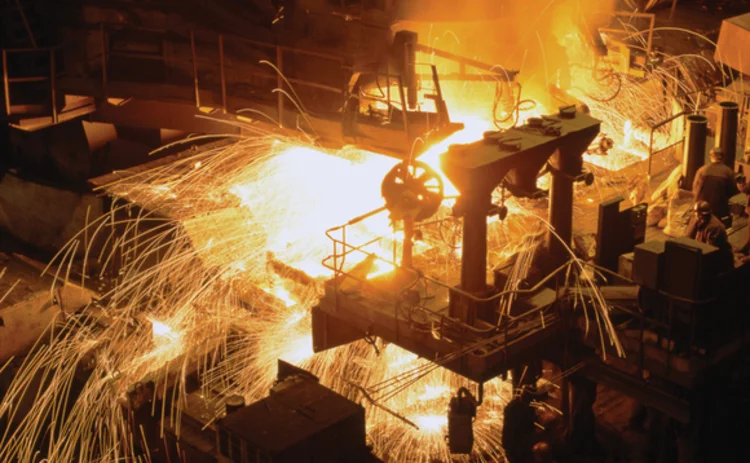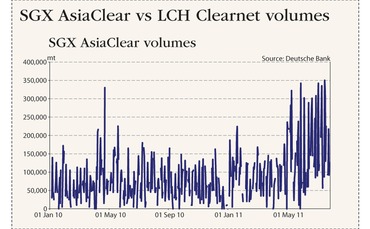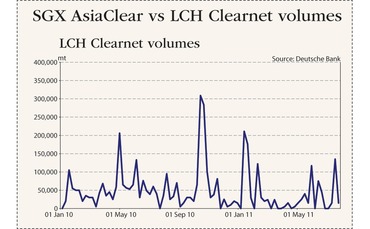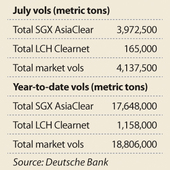
Forging an iron ore derivatives market in Asia
Last year’s shift in the way iron ore price is negotiated – which pushed the industry into more market-based contracts – has helped drive iron ore swaps volumes. The greater liquidity means swaps are increasingly legitimised as a hedging tool but end-users still have a limited role in the market

Iron ore in many ways is emerging as an Asian commodity. Most of the world's steel mills – the buyers – are located in countries such as Japan, South Korea and China. So too are many of the largest producers – the mining operations – with countries such as Australia, India and China among the biggest producers and rubbing shoulders with the likes of Brazil, Russia and South Africa.
The way that contracts between buyers and sellers of ore are agreed changed dramatically in 2010 – and this has also pushed up swap volumes. The breakthrough came in the first quarter of 2010 when agreements between Brazilian mining company Vale and Anglo-Australian miner BHP Billiton on one side, and Japanese and Chinese steel mills on the other, heralded an end to a long-standing system of annual negotiations to fix a benchmark price, instead of using contracts based on spot.
Pressure had been building for a shift to spot prices for some time, not least due to a standoff between the mills and the miners in 2009 when neither could agree on a price after Chinese negotiators demanded a 45% discount on the 2008 price. During ensuing years, negotiations dragged and suppliers pushed for shorter-dated contracts.
As with the formation of any new market, there was a lot of hype surrounding iron ore swaps. But many bankers say the swaps volume uptick since the shift in contract pricing has surprised to the upside. July of this year was a new monthly record, with a cleared volume of around 4.1 million tonnes, about 16% more than the previous record seen in May. This brings the 2011 volumes to about 18.8 million tonnes at the end of July – more than 2010's whole-year total.
However, the level of participation by those parties that will truly benefit from the swaps is still somewhat limited. Stuart Smith, head of corporate commodities sales for Asia at Deutsche Bank in Singapore, estimates that financial market participants and Asian trading firms probably represent about 70% of the market combined, although he notes that activity from European traders, miners and steel mills is increasing. "Out of all three of those, the steel mills are probably still the smallest subset at this stage. But what we see is actually an increase in interest from that sector – so what we anticipate going forward is probably a larger involvement from the steel mills and miners, but there will continue to be strong requirement from traders as well," he says.
As you open up a new swaps market or new instrument, it's really the intermediaries that need price risk management
Smith notes that the current 20-30% of the market taken up by steel mills and miners is to be expected, saying: "This is always the natural progression of a new market – obviously as you open up a new swaps market or new instrument, it's really the intermediaries that need price risk management."
Large miners tend to be long the product they produce and their investors tend to be comfortable taking commodity price risk in the equity return. End-users, meanwhile, quite often have some ability to pass through input prices to customers, so the price of steel mirrors the price of the iron ore to some extent. "However, the people in the middle, the traders and the financial houses who tend to be buying and selling cargoes, they're getting price risk on each side of the equation," says Smith. "They are the ones who initially require price risk management instruments."
Smith adds that while liquidity may build up with financial houses, as the market matures during the next three to four years it will become easier for the mining and steel mill communities to use the product – partly due to improved liquidity but also because of the establishment of a longer track record. He adds that the result of this may be that smaller miners and mills may be able to start using the instruments. "It's clearly an industry dominated by larger players, though it is beginning to diversify with smaller players coming in," he says.



Only users who have a paid subscription or are part of a corporate subscription are able to print or copy content.
To access these options, along with all other subscription benefits, please contact info@risk.net or view our subscription options here: http://subscriptions.risk.net/subscribe
You are currently unable to print this content. Please contact info@risk.net to find out more.
You are currently unable to copy this content. Please contact info@risk.net to find out more.
Copyright Infopro Digital Limited. All rights reserved.
You may share this content using our article tools. Printing this content is for the sole use of the Authorised User (named subscriber), as outlined in our terms and conditions - https://www.infopro-insight.com/terms-conditions/insight-subscriptions/
If you would like to purchase additional rights please email info@risk.net
Copyright Infopro Digital Limited. All rights reserved.
You may share this content using our article tools. Copying this content is for the sole use of the Authorised User (named subscriber), as outlined in our terms and conditions - https://www.infopro-insight.com/terms-conditions/insight-subscriptions/
If you would like to purchase additional rights please email info@risk.net
More on Commodity markets
Green knights? Banks step into struggling carbon credit markets
Clearer global standards and a new exchange may attract dealer entry, but supply and demand challenges remain
Bachelier – a strange new world for oil options
Model tuned to negative prices has implications for pricing, margining and delta hedging
Asian LNG derivatives trade surges on increased hedging
Expectations grow that a long-awaited Asian gas derivatives market is emerging
US courts restrict reach of Commodity Exchange Act
Recent cases make it harder to pursue instances of overseas misconduct
Esma releases first crop of position limits
Regulator moving away from publishing all limits in November
Carbon life force: derivatives defy coal's bleak future
Coal producers shorting volatility to collect premium, say traders
Plastics hedging rising amid US chemical industry boom
Several obstacles limiting potential growth, say plastics market participants
Q&A: French regulator defends Mifid II commodity rules
Mifid II won't hit energy hedging, Esma task force member says







